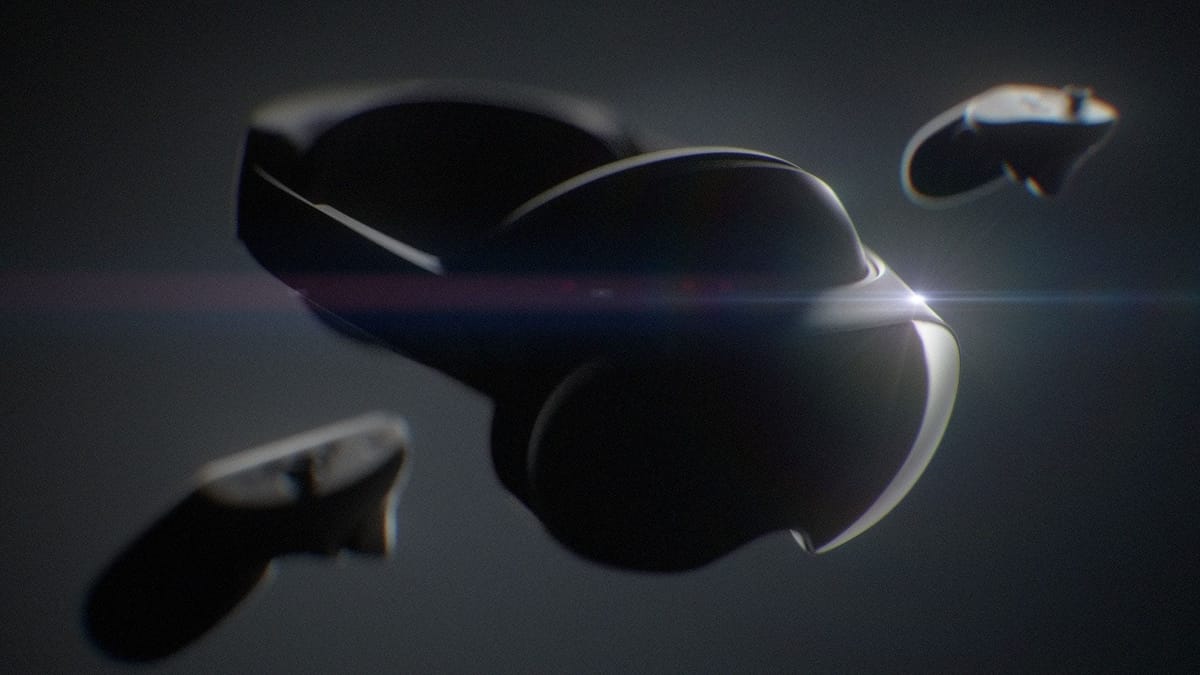- Vision Quest
- Posts
- This Week in Tech 57
This Week in Tech 57
NVIDIA takes a beating from Deepseek's announcement, Perplexity and OpenAI release AI operators and biotechnology + AI = living longer

Welcome to the cutting edge ⚔️
Read time: 7 min
Today’s Slate
Deepseek’s new AI takes a chunk out of the US market
OpenAI and Perplexity release new AI Agents
Meta and Apple continue to battle for the future of spatial computing
Science Corp. aims to plant ideas in our brains with sci-fi worthy new device
Conversations about the future with Andreessen, Lex Fridman and Google Deepmind
Boom takes supersonic flight - yes you read that right
The. Future. Is. Here.
Artificial Intelligence
At a glance
Historic Crash: Nvidia’s stock dropped 17%, erasing $600 billion in market value after DeepSeek launched its R1 AI model.
DeepSeek’s Innovation: The open-source model, trained with just $5.6 million and 2,048 Nvidia GPUs, rivals top AI systems at a fraction of the cost.
Industry Impact: Shares of Arm, Broadcom, and Oracle also fell, with global tech market losses exceeding $1 trillion.
Praise for R1: OpenAI’s Sam Altman and others praised DeepSeek’s disruptive approach, sparking new competition in AI.
Our vision
DeepSeek’s achievement challenges the AI industry’s status quo, showcasing how smaller players can innovate with fewer resources. This shift democratizes AI development, opening doors for broader innovation while forcing giants like Nvidia to adapt to a more cost-conscious future.
DeepSeek-R1 Computer Use Agents are WILD! 🤯
— Julian Goldie SEO (@JulianGoldieSEO)
10:12 AM • Jan 25, 2025
At a glance
Text-to-CAD Editor: Users describe designs in text, and Adam generates parametric CAD files instantly.
Parametric Sliders: Dynamic sliders allow for quick adjustments to the generated models.
Export Ready: Designs can be exported and 3D printed within seconds.
Conversational Design: A chat-based interface simplifies prototyping.
AI Co-Pilot Integration: In-development tools integrate with existing CAD software for smart, directed edits, making Adam the "Cursor for CAD."
Our vision
Adam is on a mission to eliminate the gap between engineering and reality, enabling more great ideas to come to life. Positioned as a trailblazer in AI-driven design, Adam is redefining mechanical design workflows and democratizing CAD tools for faster innovation across industries.
Adam tackles the inefficiencies of legacy CAD tools, which are slow, repetitive, and require significant expertise. By offering a modern, intuitive solution, Adam empowers engineers and designers to iterate rapidly and bring ideas to life without the traditional complexity.
At a glance
Perplexity has launched a new AI assistant for Android, transforming its "answer engine" into a versatile mobile helper. The assistant can:
Perform Tasks: Write emails, set reminders, book rides, and more.
Multimodal Capabilities: Interact with what's on your screen, open your camera to identify objects, and integrate with apps like Uber, YouTube, and Spotify.
App Integration: Supports common functions like messaging and scheduling but has limited compatibility with apps like Slack or Reddit.
Currently exclusive to Android, users can enable Perplexity as their default assistant through the app. Expansion to iPhone depends on Apple granting the necessary permissions.
Our vision
Perplexity’s AI assistant reimagines mobile convenience by bridging AI-driven assistance with practical everyday applications. Its multimodal abilities push boundaries, offering a taste of a future where phones function as truly intelligent companions. While still limited in app integration, Perplexity sets a foundation for smarter, more intuitive interactions with technology, nudging us closer to seamless, AI-powered living.
At a glance
OpenAI’s Operator is a groundbreaking AI agent designed to interact directly with websites, marking a leap forward in AI-assisted web navigation. Available initially to U.S. subscribers of ChatGPT Pro ($200/month), Operator can:
Autonomously Navigate Websites: Using GPT-4o’s vision and reinforcement learning, it can click, scroll, type, and interact with GUIs on web pages without requiring custom APIs.
Perform Real-World Tasks: Collaborates with platforms like DoorDash, Uber, and StubHub to book reservations, place orders, and more.
Prioritize User Safety: Requests user approval for sensitive actions (e.g., logins, emails) and blocks harmful or disallowed requests.
Self-Correct: Incorporates reasoning to handle complex tasks and ask for user intervention when needed.
OpenAI plans to extend Operator’s availability to other subscription tiers and integrate it into ChatGPT for broader accessibility.
Our vision
Operator represents a significant societal shift in how we use AI to manage everyday tasks. Unlike mobile-focused assistants like Perplexity, Operator’s ability to navigate the web autonomously brings AI closer to becoming a universal digital helper. By streamlining tasks like booking services or managing logistics, it enhances productivity while lowering the technical barriers for users.
As Operator evolves, its seamless integration into professional and personal workflows has the potential to redefine how we interact with the internet, making the once-distant concept of a personal AI assistant a reality for everyone.
Spatial Computing
At a glance
Apple continues developing microLED display technology at a secretive facility in Santa Clara, aiming for its potential use in future AR glasses. Key details include:
MicroLED Technology: A next-gen display tech that’s self-emissive like OLED but significantly more power-efficient, ideal for AR glasses requiring small batteries and high brightness for outdoor visibility.
Competitor Activity: Meta has secured a UK microLED startup’s output, and Google acquired a US-based microLED company. Early microLED displays are already seen in devices like Meta’s Orion prototypes and RayNeo X2 glasses.
Apple’s AR Timeline: Full-featured AR glasses are unlikely before 2028. However, simpler smart glasses akin to Meta’s Ray-Ban models are being explored for a 2027 release.
Challenges: Apple’s prior plans for AR glasses were postponed indefinitely in 2023, and the current work is still in its infancy.
Our vision
Apple’s ongoing investment in microLED displays reflects a high-stakes race among tech giants to dominate the AR and smart glasses market, a sector already crowded by Meta’s Quest and Ray-Ban smart glasses and Google’s Android XR initiatives. With its focus on groundbreaking microLED efficiency, Apple aims to deliver hardware capable of blending slim form factors with longer battery life—two key hurdles in wearable tech.
While Apple lags competitors like Meta, who have already launched smart glasses, and Google, which is deeply entrenched in XR platforms, its eventual entry could redefine industry standards. By 2028, Apple’s AR ecosystem might evolve to rival or surpass existing offerings, shaping how we interact with digital and physical spaces in everyday life.
At a glance
Meta is reportedly working on a high-end successor to the Quest Pro, despite past cancellations of similar projects. Key details include:
Multiple Iterations: Meta previously canceled two Quest Pro successors—Funston (planned for 2024) and La Jolla (set for 2027)—citing tepid reception of the original Quest Pro.
Current Focus: Bloomberg reports Meta is now developing another high-end model, possibly tied to its ultralight Puffin project, which includes a tethered compute puck design.
Quest 4 Development: Meta is also advancing plans for Quest 4, expected in 2026, with both budget (Pismo Low) and premium (Pismo High) versions.
Strategic Challenges: Meta’s approach to hardware development reflects cautious refinement following mixed reactions to earlier products.
Our vision
Meta’s continued pursuit of high-end VR and XR hardware showcases its commitment to pushing the boundaries of immersive tech, despite setbacks. With competitors like Apple progressing in microLED displays and Google advancing Android XR, Meta’s strategy seems to hinge on refining its Quest lineup to balance accessibility and innovation.
If the new Quest Pro successor delivers a sleeker, ultralight design and superior user experience, it could reinvigorate Meta’s position in the premium market. However, the frequent cancellations highlight the challenges of meeting consumer expectations in an increasingly competitive landscape. Ultimately, Meta’s vision appears to be focused on bridging the gap between cutting-edge tech and broader adoption, ensuring its Quest series remains a cornerstone of the XR ecosystem.
Biotech
At a glance
Science Corp., co-founded by Max Hodak, aims to revolutionize brain-computer interfaces (BCIs) with biohybrid neural interfaces, fusing lab-grown neurons with animal brains to enhance cognitive capabilities.
Game-Changing Tech: Their device places a neuron-rich gel on the brain, enabling lab-grown neurons to connect with the brain’s natural network, potentially aiding recovery from strokes or injuries.
Broader Scope: Unlike current BCIs, which target specific brain regions, Science’s approach spans more areas and avoids deep implants or genetic modifications.
Ambitious Goals: Long-term visions include "downloading" thoughts or sensory experiences, akin to sci-fi concepts like Inception.
Progress & Challenges: Initial experiments with mice show promise, with primate trials starting this year. However, years of research and significant funding are required.
Our vision
Science Corp.’s work feels like science fiction turning into reality. The idea of enhancing cognition or “downloading” thoughts mirrors dystopian narratives like Black Mirror or The Matrix. Yet, these innovations hold profound potential, from aiding those with neurological damage to fundamentally reshaping human communication and creativity.
As competitors like Neuralink focus on electrode-based implants, Science Corp.’s neuron-based biohybrids push boundaries further, aiming to seamlessly bridge biological and digital intelligence. Whether the future leads to groundbreaking medical advances or profound ethical dilemmas, it’s clear that the frontier of brain technology is closer than ever, promising to redefine the limits of human potential.
Transportation
At a glance
Boom Supersonic’s XB-1 test plane has officially broken the sound barrier for the first time, reaching Mach 1.1 (844 mph) during its 12th test flight over the Mojave Air & Space Port.
Historic Feat: The XB-1 broke the sound barrier three times, marking the first time a privately developed civil aircraft has done so.
Future of Air Travel: A scaled-down prototype of Boom’s planned Overture airliner, which aims to carry 64 passengers at Mach 1.7, bringing back supersonic commercial flights since the Concorde’s retirement in 2003.
Ongoing Development: Boom plans to design its own engines after parting ways with Rolls-Royce in 2022.
Big Backers: The company has secured $700M in funding and sold 35 aircraft to United Airlines and 20 to American Airlines, with the first Overture flight expected by 2030.
Our vision
Boom Supersonic is reviving the dream of high-speed air travel we haven’t seen since the Concord. Breaking the sound barrier with a privately developed aircraft is a landmark achievement, putting Boom in a position to challenge traditional aviation giants.
While competitors like NASA and Lockheed Martin are working on low-boom supersonic jets, Boom is focused on commercial viability, aiming to cut transatlantic flight times in half. If successful, supersonic travel could return as a mainstream luxury, reshaping global connectivity—but the next challenge is proving the economics work at scale.
Conversations about the future
Marc Andreessen and Lex Fridman
Here's my 4-hour conversation with Marc Andreessen (@pmarca), where we discuss a positive vision for the future of America, given the many challenges we face. We talk about the state of the tech industry, the heated AI race, immigration, power & corruption in politics, and of… x.com/i/web/status/1…
— Lex Fridman (@lexfridman)
9:08 PM • Jan 26, 2025
Google Deepmind and how AI will tackle our biggest challenges in life
How did you like this week's edition? |







